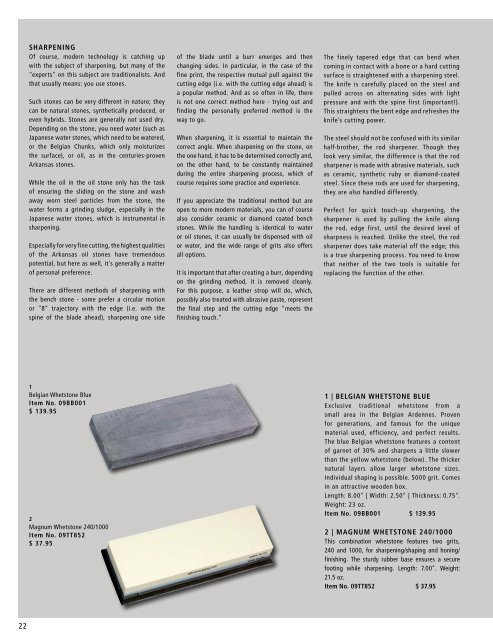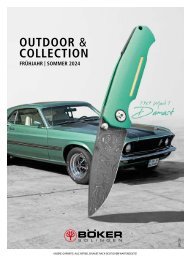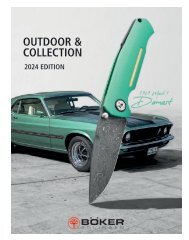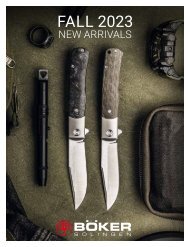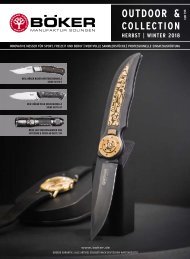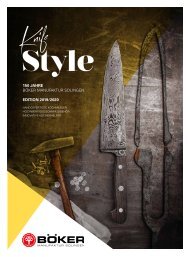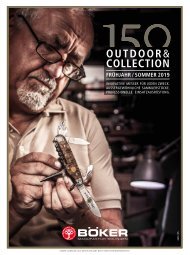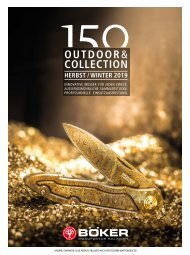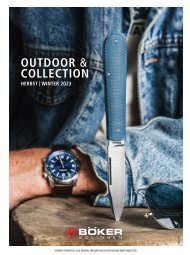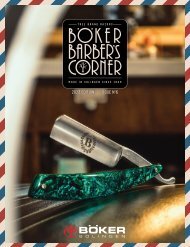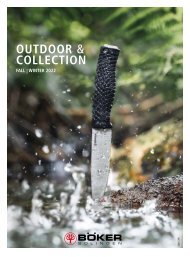Knifestyle | BUSA Edition 2022
Create successful ePaper yourself
Turn your PDF publications into a flip-book with our unique Google optimized e-Paper software.
SHARPENING<br />
Of course, modern technology is catching up<br />
with the subject of sharpening, but many of the<br />
"experts" on this subject are traditionalists. And<br />
that usually means: you use stones.<br />
Such stones can be very different in nature; they<br />
can be natural stones, synthetically produced, or<br />
even hybrids. Stones are generally not used dry.<br />
Depending on the stone, you need water (such as<br />
Japanese water stones, which need to be watered,<br />
or the Belgian Chunks, which only moisturizes<br />
the surface), or oil, as in the centuries-proven<br />
Arkansas stones.<br />
While the oil in the oil stone only has the task<br />
of ensuring the sliding on the stone and wash<br />
away worn steel particles from the stone, the<br />
water forms a grinding sludge, especially in the<br />
Japanese water stones, which is instrumental in<br />
sharpening.<br />
Especially for very fine cutting, the highest qualities<br />
of the Arkansas oil stones have tremendous<br />
potential, but here as well, it's generally a matter<br />
of personal preference.<br />
There are different methods of sharpening with<br />
the bench stone - some prefer a circular motion<br />
or "8" trajectory with the edge (i.e. with the<br />
spine of the blade ahead), sharpening one side<br />
of the blade until a burr emerges and then<br />
changing sides. In particular, in the case of the<br />
fine print, the respective mutual pull against the<br />
cutting edge (i.e. with the cutting edge ahead) is<br />
a popular method. And as so often in life, there<br />
is not one correct method here - trying out and<br />
finding the personally preferred method is the<br />
way to go.<br />
When sharpening, it is essential to maintain the<br />
correct angle. When sharpening on the stone, on<br />
the one hand, it has to be determined correctly and,<br />
on the other hand, to be constantly maintained<br />
during the entire sharpening process, which of<br />
course requires some practice and experience.<br />
If you appreciate the traditional method but are<br />
open to more modern materials, you can of course<br />
also consider ceramic or diamond coated bench<br />
stones. While the handling is identical to water<br />
or oil stones, it can usually be dispensed with oil<br />
or water, and the wide range of grits also offers<br />
all options.<br />
It is important that after creating a burr, depending<br />
on the grinding method, it is removed cleanly.<br />
For this purpose, a leather strop will do, which,<br />
possibly also treated with abrasive paste, represent<br />
the final step and the cutting edge "meets the<br />
finishing touch."<br />
The finely tapered edge that can bend when<br />
coming in contact with a bone or a hard cutting<br />
surface is straightened with a sharpening steel.<br />
The knife is carefully placed on the steel and<br />
pulled across on alternating sides with light<br />
pressure and with the spine first (important!).<br />
This straightens the bent edge and refreshes the<br />
knife's cutting power.<br />
The steel should not be confused with its similar<br />
half-brother, the rod sharpener. Though they<br />
look very similar, the difference is that the rod<br />
sharpener is made with abrasive materials, such<br />
as ceramic, synthetic ruby or diamond-coated<br />
steel. Since these rods are used for sharpening,<br />
they are also handled differently.<br />
Perfect for quick touch-up sharpening, the<br />
sharpener is used by pulling the knife along<br />
the rod, edge first, until the desired level of<br />
sharpness is reached. Unlike the steel, the rod<br />
sharpener does take material off the edge; this<br />
is a true sharpening process. You need to know<br />
that neither of the two tools is suitable for<br />
replacing the function of the other.<br />
3 - 5 | BOKER WHETSTONES<br />
These high quality combination whetstones are a<br />
must for your valuable kitchen knives. The excess<br />
width provides plenty of work surface, and the<br />
sturdy rubber base ensures a secure footing while<br />
sharpening. Dimensions: 7.00" x 2.50" x 1.25".<br />
Available in three versions:<br />
3 | BOKER WHETSTONE 600/1500<br />
Features two grits, 600 and 1500, for sharpening/<br />
shaping and honing.<br />
Item No. 09BO195 $ 49.95<br />
4 | BOKER WHETSTONE 2000/5000<br />
Features two grits, 2000 and 5000, for refreshing<br />
the sharpness and fine honing. Ideal for regular<br />
maintenance, offering a particularly fine finish.<br />
Item No. 09BO196 $ 64.95<br />
5 | BOKER WHETSTONE 3000/8000<br />
Features two grits, 3000 and 8000. Ideal for the<br />
demanding user, offering maximum fineness for<br />
smooth, precise cutting.<br />
Item No. 09BO197 $ 69.95<br />
6 | ARBOLITO SHARPENING STEEL<br />
Traditional sharpening steel for any kitchen knife.<br />
Also ideal for our Arbolito Series (shown on pages<br />
16-17).<br />
Item No. 03BA8301 $ 19.95<br />
3<br />
Boker Whetstone 600/1500<br />
Item No. 09BO195<br />
$ 49.95<br />
4<br />
Boker Whetstone 2000/5000<br />
Item No. 09BO196<br />
$ 64.95<br />
5<br />
Boker Whetstone 3000/8000<br />
Item No. 09BO197<br />
$ 69.95<br />
1<br />
Belgian Whetstone Blue<br />
Item No. 09BB001<br />
$ 139.95<br />
2<br />
Magnum Whetstone 240/1000<br />
Item No. 09TT852<br />
$ 37.95<br />
1 | BELGIAN WHETSTONE BLUE<br />
Exclusive traditional whetstone from a<br />
small area in the Belgian Ardennes. Proven<br />
for generations, and famous for the unique<br />
material used, efficiency, and perfect results.<br />
The blue Belgian whetstone features a content<br />
of garnet of 30% and sharpens a little slower<br />
than the yellow whetstone (below). The thicker<br />
natural layers allow larger whetstone sizes.<br />
Individual shaping is possible. 5000 grit. Comes<br />
in an attractive wooden box.<br />
Length: 8.00" | Width: 2.50" | Thickness: 0.75".<br />
Weight: 23 oz.<br />
Item No. 09BB001 $ 139.95<br />
2 | MAGNUM WHETSTONE 240/1000<br />
This combination whetstone features two grits,<br />
240 and 1000, for sharpening/shaping and honing/<br />
finishing. The sturdy rubber base ensures a secure<br />
footing while sharpening. Length: 7.00". Weight:<br />
21.5 oz.<br />
Item No. 09TT852 $ 37.95<br />
7 | SIEGER LONG LIFE SHARPENER<br />
This sharpener, made of synthetic ruby, is 20 times<br />
harder than hardened steel (20,000 Knoop hardness,<br />
which is roughly a 200 hardness in Rockwell units)!<br />
The most unusual aspect of this sharpener is the<br />
high efficiency (taking less time for sharpening), in<br />
combination with an extraordinarily fine edge, allowing<br />
superior edge retention. In addition, this sharpener will<br />
last longer than a diamond sharpener, as it is not a<br />
coated instrument but one of bulk material. Can be<br />
used either wet or dry, and can be simply cleaned with<br />
a dish sponge. Length: 8.00".<br />
Item No. 09SR001 $ 129.95<br />
8 | BOKER STROP TOP FINISH<br />
The Boker Strop Top Finish features specially treated<br />
cowhide on both sides, for an especially long life.<br />
It gives any blade the perfect finish after the knife<br />
has been sharpened on a stone like the Belgian<br />
"Brocken." Both surfaces are perfect for working<br />
with the grinding pastes from the Boker lineup. Work<br />
surface: 1.62" x 10.25".<br />
Item No. 090508 $ 109.95<br />
6<br />
Arbolito Sharpening Steel<br />
Item No. 03BA8301<br />
$ 19.95<br />
7<br />
Sieger Long Life Sharpener<br />
Item No. 09SR001<br />
$ 129.95<br />
8<br />
Boker Strop Top Finish<br />
Item No. 090508<br />
$ 109.95<br />
22 23


